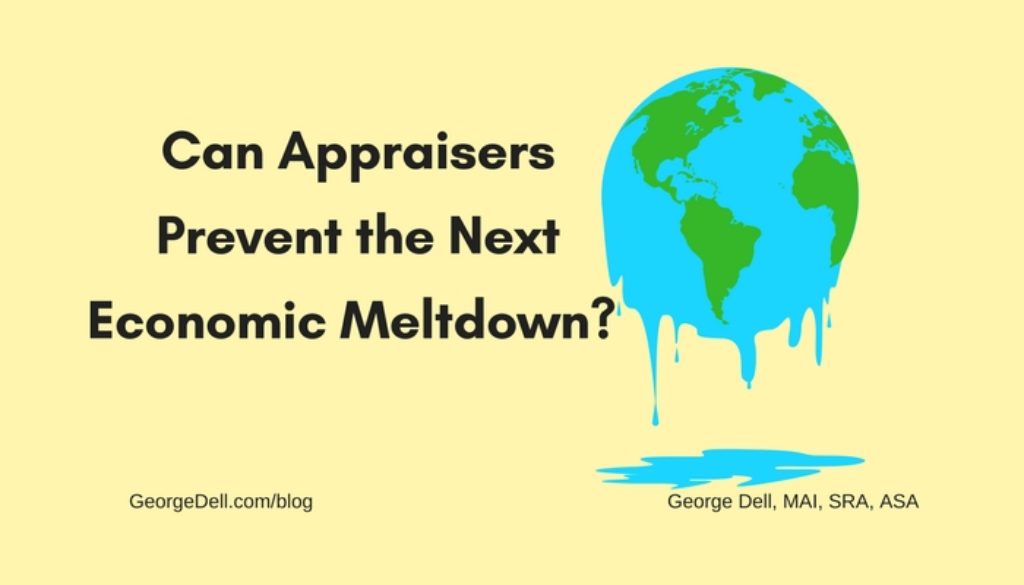The last economic meltdown happened because something wasn’t working. Appraisers can take two attitudes: 1) They are just reporters of “expected selling prices”; 2) They are just following standards. Is it the lenders and underwriters who determine risk, or is it appraisers? So appraisers can say they only do as they are told. Is this a reasonable stance?
Let’s take a look.
The Appraisal Standards Board (ASB) offers advice, regarding “market value” as required for most home lending (Advisory Opinion 22). There are seven conditions in the offered definition:
- Participants act prudently and knowledgeably;
- Price is not affected by undue stimulus;
- Participants are typically motivated;
- Participants are well informed or well advised;
- Market exposure time is reasonable;
- Payment is in cash or equivalent;
- Price is unaffected by special or creative financing or concessions.
Please ask – what was the true operative definition? What was actually happening?
- Participants were acting speculatively with exuberance;
- Price was affected by universal euphoria;
- Participants were avariciously motivated;
- Participants were uninformed and advised by commissioned salespeople;
- Market exposure time was impulsively fast;
- Payment is in cash or equivalent;
- Price is enabled by unrestricted special and creative financing.
We got one out of seven – not bad . . .
Were appraisers at fault? Was appraisal work acceptable? Let’s take a look.
USPAP (Uniform Standards of Professional Appraisal Practice) has a simple test for “acceptable” scope of work: 1) It is what clients expect. 2) It is what appraiser peers do. The words “reliable” and “accurate” are not part of the tests of the appraiser’s opinion. The official test is something else.
Lender clients expect to make loans based on the cash equivalent price. Effectively, all appraisers were reporting the expected selling price: 1) what clients expected; 2) what appraisers were all doing.
The next economic meltdown, helped or caused by speculative prices, will not be stopped by appraisers. They are required to report a believable opinion only, not an accurate or reliable result. The test of believability (credibility) is based on client expectations, and groupthink.
What do you think?

March 28, 2018 @ 1:16 pm
Very good George. I’m going out and buy an extra shovel in case someone wants a ditch dug.
It maybe be safer.
Just attended a class presented by Steve Roach. He made the class enjoyable and understandable.
It seems that maybe some of your good stuff rubbed off.
Hoping AI has changed their approach, make in enjoyable, easily understood, and how to apply
it to everyday problems.
Looking forward to taking you Stat’s class again. Hope somewhere close to Reno.
Thanks
March 29, 2018 @ 6:12 am
There is a often significant disconnect between the conditions imposed on the market by our value definitions (notably the definition of market value used for mortgage lending), and the actual market in which real estate transactions take place. The definition of market value presumes something resembling the semi-perfect market of neoclassical economics, when the market itself is quite different, as aptly observed during the last economic meltdown.
I would argue, as Richard Ratcliff and others have argued for years, that we’d be better off presenting the real world as it exists, without artificial constraints, which many appraisers ignore in actual practice anyway. If the market is irrational or speculative, so be it. BUT, we can also present our valuation opinions with an analysis of the variability and risk associated with such opinion. IMHO, that would be something of value . . . an opinion based on the real market (not an idealized semi-perfect one), with additional analysis or commentary about upside/downside risk.
April 24, 2018 @ 9:17 am
Appraisers cannot prevent the next meltdown, anymore than they can be blamed for creating the last one. However, as a review appraiser and Chief Appraiser I often take the opportunity in my reviews to point to signs of speculative froth or unusual risk factors in a particular transaction. Recently I reviewed an appraisal of a build-to-suit industrial building where the tenant was agreeing to pay a rent that was above market. The appraiser either didn’t pick up on this or didn’t want to pick up on this. I pointed out in my review that there was enormous risk in this property if the single tenant in question vacated the building – it would be very difficult if not impossible to re-lease the building for the rent the build-to-suit tenant was paying. I’m not sure that did any good, but at least I warned the underwriter working the deal of the risk involved.